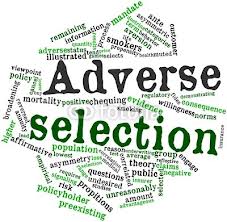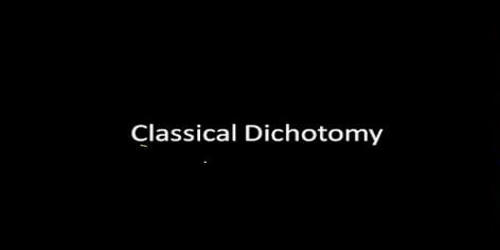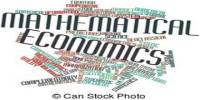Adverse selection, anti-selection, or negative selection is a term used in economics, insurance, statistics, and risk management. It refers to a market process in which “bad” results occur when buyers and sellers have asymmetric information (i.e. access to different information): the “bad” products or services are more likely to be selected. A bank that sets one price for all its checking account customers runs the risk of being adversely selected against by its low-balance, high-activity (and hence least profitable) customers. Two ways to model adverse selection are with signaling games and screening games.
Example: insurance
The term adverse selection was originally used in insurance. It describes a situation where an individual’s demand for insurance (either the propensity to buy insurance, or the quantity purchased, or both) is positively correlated with the individual’s risk of loss (e.g. higher risks buy more insurance), and the insurer is unable to allow for this correlation in the price of insurance. This may be because of private information known only to the individual (information asymmetry), or because of regulations or social norms which prevent the insurer from using certain categories of known information to set prices (e.g. the insurer may be prohibited from using information such as gender or ethnic origin or genetic test results). The latter scenario is sometimes referred to as ‘regulatory adverse selection’.
The potentially ‘adverse’ nature of this phenomenon can be illustrated by the link between smoking status and mortality. Non-smokers, on average, are more likely to live longer, while smokers, on average, are more likely to die younger. If insurers do not vary prices for life insurance according to smoking status, life insurance will be a better buy for smokers than for non-smokers. So smokers may be more likely to buy insurance, or may tend to buy larger amounts, than non-smokers. The average mortality of the combined policyholder group will be higher than the average mortality of the general population. From the insurer’s viewpoint, the higher mortality of the group which ‘selects’ to buy insurance is ‘adverse’. The insurer raises the price of insurance accordingly. As a consequence, non-smokers may be less likely to buy insurance (or may buy smaller amounts) than if they could buy at a lower price to reflect their lower risk. The reduction in insurance purchase by non-smokers is also ‘adverse’ from the insurer’s viewpoint, and perhaps also from a public policy viewpoint.
Furthermore, if there is a range of increasing risk categories in the population, the increase in the insurance price due to adverse selection may lead the lowest remaining risks to cancel or not renew their insurance. This leads to a further increase in price, and hence the lowest remaining risks cancel their insurance, leading to a further increase in price, and so on. Eventually this ‘adverse selection spiral’ might in theory lead to the collapse of the insurance market.
To counter the effects of adverse selection, insurers (to the extent that laws permit) ask a range of questions and may request medical or other reports on individuals who apply to buy insurance, so that the price quoted can be varied accordingly, and any unreasonably high or unpredictable risks rejected. This risk selection process is known as underwriting. In many countries, insurance law incorporates an ‘utmost good faith’ or uberrima fides doctrine which requires potential customers to answer any underwriting questions asked by the insurer fully and honestly; if they fail to do this, the insurer may later refuse to pay claims.
Whilst adverse selection in theory seems an obvious and inevitable consequence of economic incentives, empirical evidence is mixed. Several studies investigating correlations between risk and insurance purchase have failed to show the predicted positive correlation for life insurance, auto insurance, and health insurance. On the other hand, “positive” test results for adverse selection have been reported in health insurance, long-term care insurance and annuity markets. These “positive” results tend to be based on demonstrating more subtle relationships between risk and purchasing behavior (e.g. between mortality and whether the customer chooses a life annuity which is fixed or inflation-linked), rather than simple correlations of risk and quantity purchased.
One reason why adverse selection may be muted in practice may be that insurers’ underwriting is largely effective. Another possible reason is negative correlation between risk aversion (e.g. insurance purchasers) and risk level (e.g. level of observed claims) in the population: if risk aversion is higher amongst lower risk customers, adverse selection can be reduced or even reversed, leading to ‘propitious’ or ‘advantageous’ selection. For example, there is evidence that smokers are more willing to do risky jobs than non-smokers ,and this greater willingness to accept risk might reduce insurance purchase by smokers. From a public policy viewpoint, some adverse selection can also be advantageous because it may lead to a higher fraction of total losses for the whole population being covered by insurance than if there were no adverse selection.
In studies of health insurance, an individual mandate requiring people to either purchase plans or face a penalty is cited as a way out of the adverse selection problem by broadening the risk pool.[14] Mandates, however, increase moral hazard.
The Market for Lemons
“The Market for Lemons: Quality Uncertainty and the Market Mechanism” is a 1970 paper by the economist George Akerlof. It discusses information asymmetry, which occurs when the seller knows more about a product than the buyer. A lemon is a slang term in America for a bad car, i.e. a “clunker”. Akerlof, Michael Spence, and Joseph Stiglitz jointly received the Nobel Memorial Prize in Economic Sciences in 2001 for their research related to asymmetric information. Akerlof’s paper uses the market for used cars as an example of the problem of quality uncertainty. It concludes that owners of good cars will not place their cars on the used car market. This is sometimes summarized as “the bad driving out the good” in the market.
The Used Cars uncertainty problem
Akerlof’s paper uses the market for used cars as an example of the problem of quality uncertainty. A used car is one in which ownership is transferred from one person to another, after a period of use by its first owner and its inevitable wear and tear. There are good used cars (“cherries”) and defective used cars (“lemons”), normally as a consequence of several not-always-traceable variables such as the owner’s driving style, quality and frequency of maintenance and accident history. Because many important mechanical parts and other elements are hidden from view and not easily accessible for inspection, the buyer of a car does not know beforehand whether it is a cherry or a lemon. So the buyer’s best guess for a given car is that the car is of average quality; accordingly, he/she will be willing to pay for it only the price of a car of known average quality. This means that the owner of a carefully maintained, never-abused, good used car will be unable to get a high enough price to make selling that car worthwhile.
Therefore, owners of good cars will not place their cars on the used car market. The withdrawal of good cars reduces the average quality of cars on the market, causing buyers to revise downward their expectations for any given car. This, in turn, motivates the owners of moderately good cars not to sell, and so on. The result is that a market in which there is asymmetrical information with respect to quality shows characteristics similar to those described by Gresham’s Law: the bad drives out the good (although Gresham’s Law applies to a different situation).
“Lemon market” effects have also been noted in other markets, such as used computers[citation needed] . There are also parallels in the insurance market, where, unless those least likely to need insurance (i.e., those least likely to get in accidents) are forced to buy insurance, it is those most likely to need insurance compensation who tend most to buy insurance.
Suppose we can use some number, q to index the quality of used cars, where q is uniformly distributed over the interval [0,1]. The average quality of a used car which could be supplied to the market is therefore 1/2. There are a large number of buyers looking for cars who are prepared to pay their reservation price of \frac 3 2 q for a car that is of quality q. There are also a large number of sellers who are prepared to sell a car of quality q for the price q. If quality were observable, the price of used cars would therefore be somewhere between q and \frac 3 2 q, and the cars would be sold and everyone would be perfectly happy. If the quality of cars is not observable by the buyers, then it seems reasonable for them to estimate the quality of a car offered to market using the average quality of all cars.
Based on this estimation, the willingness to pay for any given car will therefore be \frac 3 2 q_{avg}, where qavg is the average quality of all the cars. Now, assume that the equilibrium price in the market is some price, p, where p > 0. At this price, all the owners of cars with quality less than p will want to offer their cars for sale. Since again, quality is uniformly distributed over the interval from 0 to this p, the average quality of the cars offered for sale at p will be worth only p/2. We know however that for an expected quality worth p/2, buyers will only be willing to pay (3/2)(p/2) = \frac 3 4 p. Therefore we can conclude that no cars will be sold at p. Because p is any arbitrary positive price, it is shown that no cars will be sold at any positive price at all. The market for used cars collapses when there is asymmetric information.
Asymmetric information
The paper by Akerlof describes how the interaction between quality heterogeneity and asymmetric information can lead to the disappearance of a market where guarantees are indefinite. In this model, as quality is undistinguishable beforehand by the buyer (due to the asymmetry of information), incentives exist for the seller to pass off low-quality goods as higher-quality ones. The buyer, however, takes this incentive into consideration, and takes the quality of the goods to be uncertain. Only the average quality of the goods will be considered, which in turn will have the side effect that goods that are above average in terms of quality will be driven out of the market. This mechanism is repeated until a no-trade equilibrium is reached.
As a consequence of the mechanism described in this paper, markets may fail to exist altogether in certain situations involving quality uncertainty. Examples given in Akerlof’s paper include the market for used cars, the death of formal credit markets in developing countries, and the difficulties that the elderly encounter in buying health insurance. However, not all players in a given market will follow the same rules or have the same aptitude of assessing quality. So there will always be a distinct advantage for some vendors to offer low-quality goods to the less-informed segment of a market that, on the whole, appears to be of reasonable quality and have reasonable guarantees of certainty. This is part of the basis for the idiom, buyer beware.
There is no reciprocal danger of a market for a good product collapsing in this manner when the asymmetry is in favour of the buyer,[dubious – discuss] that is to say, when the buyers can assess more accurately the quality of the products than the sellers. In this case, regular market forces of supply and demand will prevail, the sellers will get the highest price paid, and the trend will be to weed out products with prices in excess of their quality.
This is likely the basis for the idiom that an informed consumer is a better consumer. An example of this might be the subjective quality of fine food and wine. Individual consumers know best what they prefer to eat, and quality is almost always assessed in fine establishments by smell and taste before they pay. That is, if a customer in a fine establishment orders a lobster and the meat is not fresh, he can send the lobster back to the kitchen and refuse to pay for it. However, a definition of ‘highest quality’ for food eludes providers. Thus, a large variety of better quality and higher priced restaurants are supported.
George E. Hoffer and Michael D. Pratt state that the “economic literature is divided on whether a lemons market actually exists in used vehicles.” The authors’ research supports the hypothesis that “known defects provisions,” used by US states (e.g., Wisconsin) to regulate used car sales have been ineffectual, because the quality of used vehicles sold in these states is not significantly better than the vehicles in neighboring states without such consumer protection legislation.[1]
Both the American Economic Review and the Review of Economic Studies rejected the paper for “triviality”, while the reviewers for Journal of Political Economy rejected it as incorrect, arguing that if this paper was correct, then no goods could be traded. Only on the 4th attempt did the paper get published in Quarterly Journal of Economics.[2] Today, the paper is one of the most-cited papers in modern economic theory (more than 8,530 citations in academic papers as of May 2011),[3] and has profoundly influenced economic thinking in virtually every field of economics, from industrial organization and public finance to macroeconomics and contract theory.
A lemon market will be produced by the following:
Asymmetry of information, in which no buyers can accurately assess the value of a product through examination before sale is made and all sellers can more accurately assess the value of a product prior to sale
An incentive exists for the seller to pass off a low quality product as a higher quality one
Sellers have no credible disclosure technology (sellers with a great car have no way to disclose this credibly to buyers)
Either a continuum of seller qualities exists or the average seller type is sufficiently low (buyers are sufficiently pessimistic about the seller’s quality)
Deficiency of effective public quality assurances (by reputation or regulation and/or of effective guarantees/warranties)
The article draws some conclusions about the cost of dishonesty in markets in general:
“ The cost of dishonesty, therefore, lies not only in the amount by which the purchaser is cheated; the cost also must include the loss incurred from driving legitimate business out of existence
















